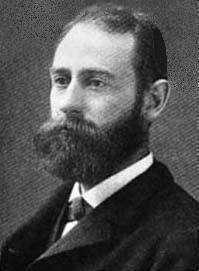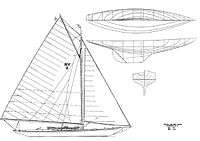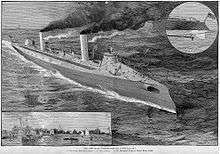Nathanael Greene Herreshoff
| Nathanael Greene Herreshoff | |
|---|---|
 Herreshoff circa 1898 | |
| Born |
March 18, 1848 Bristol, Rhode Island |
| Died |
June 2, 1938 (aged 90) Bristol, Rhode Island |
| Other names | Nickname: Captain Nat |
| Occupation |
Naval architect Mechanical engineer |
| Known for | Designing motor and sailing yachts, especially America's Cup defenders between 1893-1920 |
| Spouse(s) |
Clara Anna DeWolf Ann Roebuck |
| Children |
Agnes Muller Herreshoff Lewis Francis Herreshoff[1] |
| Relatives |
J. B. F. Herreshoff, brother Charles F. Herreshoff, nephew L. Francis Herreshoff, son Halsey Chase Herreshoff, grandson |
Nathanael Greene Herreshoff (March 18, 1848 – June 2, 1938) was an American naval architect, mechanical engineer, and yacht design innovator. He produced a succession of undefeated America's Cup defenders between 1893-1920.
Biography
Herreshoff was born on March 18, 1848 in Bristol, Rhode Island and was named after General Nathanael Greene.[1] He was the youngest of three brothers, behind Lewis and John B.[2]
He graduated from the Massachusetts Institute of Technology in 1870 with a three-year degree in mechanical engineering.[3] After graduation, he took a position with the Corliss Steam Engine Company in Providence, Rhode Island. At the 1876 Centennial Exposition in Philadelphia, Pennsylvania, he oversaw operation of the Corliss Stationary Engine, a 40-foot-tall (12 m), 1,400-horsepower (1,000 kW) dynamo that powered the exhibition's machinery.[4]
In 1878 Herreshoff returned to Bristol where he and his older brother John B. formed the Herreshoff Manufacturing Company. Herreshoff provided the engineering expertise and his brother provided the business expertise, managing the firm's personnel and interacting with clients. Together, they grew the business from about 20 employees to over 400.[5] In 1888, a serious accident occurred while Herreshoff was supervising speed trials of a 138-foot (42 m), 875-horsepower (652 kW) steamboat named Say When. After a safety valve opened to release over-pressure, Herreshoff closed it so the boat could achieve its anticipated maximum speed. But a boiler exploded, fatally injuring a member of the crew. Consequently, Herreshoff lost his steam engineer's license.[4]
Herreshoff was an accomplished sailor.
Two of Herreshoff's sons would also become yacht designers: Sidney Dewolf Herreshoff and Lewis Francis Herreshoff.
He died on June 2, 1938 in Bristol, Rhode Island.[6]
Yacht building


While the firm's early work centered on steam-powered vessels, by the 1890s the Herreshoffs turned to the design and construction of yachts for wealthy American clients, including Jay Gould, William Randolph Hearst, John Pierpont Morgan, Cornelius Vanderbilt III, Harold Stirling Vanderbilt, William Kissam Vanderbilt II, Harry Payne Whitney and Alexander Smith Cochran. Herreshoff boat production incorporated power tools that increased productivity at a high level of quality, using craftsmen that received the highest boat-builder wages in the state of Rhode Island.[7]
Herreshoff was noted as an innovative sailboat designer of his time. His designs ranged from the 12½, a 16-foot (12½ foot waterline) sailboat for training the children of yachtsmen, to the 144-foot America's Cup Reliance, with a sail area of 16,000 square feet.[8] He received the first US patent for a sailing catamaran. The firm built the America's Cup winning Cup yachts Enterprise - 1930, and Rainbow - 1934 (designed by Starling Burgess). Every winning America's Cup Yacht from 1893 to 1934 was built by the Herreshoff yard.
The 123-foot Defender featured steel-framing, bronze plating up to the waterline and aluminum topsides to achieve a lighter and faster boat. This combination of materials had been pioneered in the French fresh-water racing yacht Vendenesse, which had been described in a New York Times article and caught the attention of the Vanderbilt Americacup syndicate. In salt water, Defender was subject to galvanic corrosion, which limited its durability in water. Defender won the America's Cup in 1895 over Lord Dunraven's Valkyrie III, and she was used as an effective trial-horse for Herreshoff's new Cup defender Columbia in 1899. She was broken up in 1901.
Those of the 2,000-plus designs by Herreshoff that survive are sought by connoisseurs of classic yachts. Herreshoff S-Class sailboats, designed in 1919 and built until 1941, are still actively raced in Narragansett Bay, Buzzards Bay and Western Long Island Sound (Larchmont, New York). His 12½ design of 1914 is still being built and raced in New England as well. The New York 30 is well regarded as a one-design racer/cruiser.
The Herreshoff Marine Museum preserves Herreshoff's legacy at the former site of the Herreshoff Manufacturing Co.
Notable vessels

Steam vessels
- Lightning—the US Navy's first purpose-built torpedo boat—a speed record breaking steam launch with a spar torpedo, 1876.[3][9][10]
Sailing vessels
In the last quarter of the 19th century, Herreshoff constructed a double-hulled sailing boat of his own design (US Pat. No. 189,459). The craft, Amaryllis, raced at her maiden regatta on June 22, 1876 and performed exceedingly well. Her debut demonstrated the distinct performance advantages afforded by catamarans over the standard monohulls. It was as a result of this event, the Centennial Regatta of the New York Yacht Club, that catamarans were barred from regular sailing classes, and this remained the case until the 1970s.[11]
- Amaryllis—Herreshoff sailing catamaran, 1876
- Helianthus III, 1924
America's Cup yachts
Herreshoff designed and built the following America's Cup contenders. All won the series against their challengers. Herreshoff was the helmsman of Vigilant.
Summary of technical achievements


According to his son's biography of Herreshoff's career of 72 years, Herreshoff achieved the following:[3]
- Designed and built five winning America's Cup yachts.
- Designed well over 2000 craft and produced more than 18,000 drawings. Between 1890 and 1938, the number of yachts he designed that won the Astor Cup, Puritan Cup and Kings Cup outnumbered the winning yachts of all rival yacht designers combined.
- Built the first torpedo boats for the U.S. Navy.
- Developed the first handicapping formula (the Herreshoff Rule) to allow yachts of different sizes and types to race together.
- Developed yacht scantlings (specifications) based on scientific load calculations; prior to Herreshoff, most yacht designers simply relied on traditional rules of thumb to determine the proper dimensions for planks, frames and rigs.
- Invented streamlined bulb and fin keels.
- Invented the sail track and slide in its present form along with many other patterns of marine hardware.
- Developed long overhangs on racing yachts that produced longer immersed waterlines, hence greater speed, when underway.
- Developed the first light steam engine and fast torpedo boats.
- Developed nearly all of the methods of constructing light wooden hulls.
- Introduced screw fastenings for planking to this country.
- Invented the crosscut sail, with panels running at right angles to the leech, in order to combat cotton canvas' tendency to distort under load.
- Designed more types of steam engines than anyone else.
- Designed the web frame and longitudinal construction for metal hulls afterward patented and known as the Isherwood System.
- Developed light hollow metal spars combined with scientifically engineered rigging.
- Developed the flat stern form of steam yachts capable of being driven at high speed/length ratios.
- Designed the first folding propeller.
- Designed below-deck winches - Reliance 1903.
- Developed the method of splicing rope to wire.
- Herreshoff yachts were the first to attach shrouds and stays to mast tangs.
- Invented the modern turnbuckle.
- Invented sail tracks on masts and slides attached to the luff of sails to ride in the tracks (up until then, sails had been attached with mast hoops or laced to masts).
- Invented the modern winch.
- Received the first U.S. patent on catamaran sailboats (the Amaryllis, 1876).
See also
| Wikimedia Commons has media related to Herreshoff. |
References
- 1 2 Richard V. Simpson (2007). Herreshoff Yachts: Seven Generations of Industrialists, Inventors and ... The History Press. p. 16. ISBN 1-59629-306-3.
Nathanael Greene Herreshoff III offers the following: Captain Nat, a seventh child, was named after Revolutionary ...
- ↑ "Lewis Herreshoff Dead. Brother of Men who Built Defenders of the America's Cup". New York Times. February 17, 1926. Retrieved 2011-04-26.
- 1 2 3 L. Francis Herreshoff, Capt. Nat Herreshoff: The Wizard of Bristol; Sheridan House, Dobbs Ferry, New York 1953
- 1 2 Simpson, Richard V. (2007). Herreshoff Yachts. Charleston, South Carolina: The History Press.
- ↑ Orison Swett Marden (1901). "Chapter 17 - Herreshoff, the Yacht Builder". How they succeed. Lothrop Publishing Co. pp. 276–303.
- ↑ "America's Cup Yacht Designer Dies at 91". Associated Press. June 3, 1938. Retrieved 2011-04-26.
Captain Nathanael Greene Herreshoff know in the yachting world ... a descendant of Charles Frederick Herreshoff who emigrated from Germany in ... He died in 1891. Meanwhile Herreshoff had ...
- ↑ Jones, Gregory O. (December 25, 2004). Herreshoff Sailboats. McGregor, Minnesota: Voyageur Press. p. 160. ISBN 978-0760311608.
- ↑ Pastore, Christopher (September 1, 2005). Temple to the Wind: The Story of America's Greatest Naval Architect and His Masterpiece, Reliance. Guilford, Connecticut: Lyons Press. p. 312. ISBN 1592285570.
- ↑ Richard V. Simpson (2007), "Torpedo Boats", Herreshoff Yachts: Seven Generations of Industrialists, Inventors, and Ingenuity in Bristol, The History Press, pp. 94–95, ISBN 9781596293069
- ↑ Richard V. Simpson (2001), "Three Fast Launches and Spar Torpedo Boats", Building the Mosquito Fleet: The U.S. Navy's First Torpedo Boats, Arcadia Publishing, p. 28, ISBN 9780738505084
- ↑ L. Francis Herreshoff. "The Spirit of the Times, November 24, 1877 (reprint)". Marine Publishing Co., Camden, Maine. Archived from the original on January 24, 2008. Retrieved 2014-12-02.
Bibliography
- Bray, Maynard; Pinheiro, Carlton (1989). Herreshoff of Bristol: A Photographic History of America's Greatest Yacht and Boat Builders (Hardback). Brooklin: Woodenboat Publications. ISBN 978-0-937822-19-7.
- Herreshoff, L. Francis (1996) [1953]. Capt. Nat Herreshoff: The Wizard of Bristol. Dobbs Ferry, N.Y: Sheridan House. ISBN 1-57409-004-6. OCLC 45990752.
- Herreshoff, Nathanael G. Recollections and Other Writings (Bristol, RI: Herreshoff Marine Museum)
- Herreshoff, Nathanael G. and William Picard Stephens, annotated by John W. Streeter, Nathanael Greene Herreshoff, William Picard Stephens: Their Last Letters 1930-1938 (Bristol, RI: Herreshoff Marine Museum) 1998.
- Page, Franco (2008). Herreshoff and his Yachts (Hardback). Brooklin: Woodenboat Publications. ISBN 978-0-937822-98-2.
- Simpson, Richard V. (2007). Bristol, Rhode Island's Herreshoff yachts. Charleston, South Carolina: The History Press. ISBN 978-1-59629-306-9. OCLC 226055968.